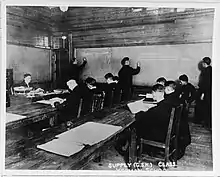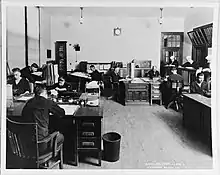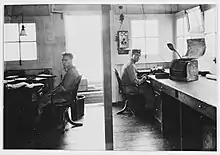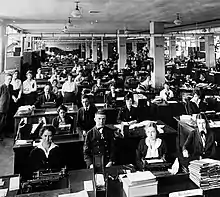Yeoman (United States Navy)
The yeoman rate is one of the oldest rates in the US Navy, dating back to 1794. Historically, the Navy yeomen were responsible for keeping the storerooms for the ship's gunners, carpenters, and boatswains. With the transition from sail to steam, yeomen were assigned to the ship's engineers. In the modern Navy, a yeoman is an enlisted service member who performs administrative and clerical work.
| Yeoman | |
|---|---|
 Rating insignia | |
| Issued by | United States Navy |
| Type | Enlisted rating |
| Abbreviation | YN / YNS |
| Specialty | Administration |
History
Formation of US Navy
The US Constitution (Article I, Section 8, Clause 14) granted the new US Congress the power to build and maintain a navy. It wasn't until 1794, when the deteriorating US relations with Great Britain and France, as well as the continuing attacks by Barbary pirates, forced Congress to appropriate funds to construct 6 frigates. Congress stipulated that each ship was to have one Yeoman of the Gun Room, and one Captain's Clerk. (The Captain's Clerk was the ancestor of the modern Yeoman.[1]) Both of these positions were considered as petty officers.[2] Carpenter's Yeoman and Gunner's Yeoman followed in 1798, and Boatswain's Yeoman in 1799.[1] In the early US Navy, The petty officers were appointed by the ship's captain, and served at his pleasure. They did not retain their rank when they moved to another ship.[3] No uniform regulations were specified for the petty officers and enlisted men until 1817.[4]
World War I era
With the US Declaration of War against Imperial Germany in April 1917, the Navy needed trained men quickly. Recruits who had the aptitude to be yeomen attended Yeoman School. As the war effort escalated, the US Navy found itself lacking personnel to perform the shore-based duties necessary to support more than 128,000 enlisted personnel.[5] On 17 March 1917, Secretary of the Navy Josephus Daniels received authorization to enlist women to perform yeoman's duties. They were designated Yeoman (F).
Yeoman School
The Yeoman School, one of the Navy's Trade Schools, had two locations: Newport RI and San Francisco CA. To enter Yeoman School, the recruit was required to have some prior clerical experience, be able to write legibly, and type a 200-word letter with a passing grade of 70% or better. Knowledge of stenography was desirable, but not required. Steno classes would be available after hours.[7]:27




Preliminary classes, lasting between 4-6 weeks, would cover arithmetic, spelling, composition, and general Navy knowledge. The final examination would determine eligibility for the next level of classes.[7]:28 Supply-officer department classes covered preparation of requisitions, surveys, public bills, official returns, and supply-related duties. General bookkeeping, inventories, mess statements, and balance sheets were also taught. Executive-officer department classes covered record-keeping for enlisted men. Correct preparation of forms for arrival/departure of men; ratings and disratings; appointments; and discharges, desertions, & death was covered. Pay-officer department classes required a thorough knowledge of arithmetic. Making up payrolls, computing pay for officers and enlisted men (including allowances, bounties, and extra pay), calculating credit and interest on payroll savings accounts, and preparing payroll checks were some of the duties covered in these classes. Commanding-officer department classes covered the production of various forms of official correspondence, such as official letters, and endorsements. The yeoman had to be familiar with the channels through which the documents would pass, as well as the approved filing systems for storing the paperwork. Generating the proceedings for courts-martial and other courts of inquiry or inquests was also covered. The use and proper care of a typewriter was extremely important in the preparation of these documents. Each of the above classes was 5 weeks long.[7]:29
Upon entering Yeoman School, the recruit's ranking was landsman-for-yeoman, with a monthly salary of $17.60. Good grades and good conduct could be rewarded with a promotion to lands-for-yeoman, second class, and a monthly salary of $20.90. Upon graduation, the ranking would be either yeoman, third class (Y3C), at $33.00 per month or yeoman, second class (Y2C), at $38.00 per month. The new yeomen would be granted 10 days leave, with additional time allowed for travel, before transferring to his next station. [7]:29
Yeoman (F)

The Civil Service Commission notified Navy Secretary Josephus Daniels in early 1917 that it could not supply the clerical support needed by the Navy. Exactly who originated the idea of enlisting women with the necessary skills is uncertain. Daniels consulted his legal staff as to whether the language of The Naval Act of 1916 prohibited women. Advised that it did not, Daniels responded, "Then enroll women in the Naval Reserve as yeomen,’ I said, ‘and we will have the best clerical assistance the country can provide.’" By war's end, there were more than 11,000 women serving as Yeoman (F) of the US Naval Reserve. The women also contributed to the war effort in non-clerical positions, replacing their male counterparts who were called for sea duty. They became switchboard operators, recruiters, code decipher clerks, painters, look-outs at naval bases, translators, and messengers. They also dispersed pay, designed ship camouflage, and manufactured munitions. As Secretary Daniels had observed, “They did everything except go to sea.”[8] Yeoman (F) recruitment stopped on 11 November 1918. The young women had enlisted for 4 years, so they remained on active duty until 1920. Afterwards, many of their supervisors urged Daniels to retain the now-discharged yeomen as civilians doing the same jobs.[8]
Sinking of USS President Lincoln

Convoy escort duty of the ships transporting men and materiel to Europe became the primary function of the US Navy during WW 1. Originally the responsibility of US Army Transport Service, which was not equipped to provide the vessels needed to transport the American Expeditionary Force (AEF) to Europe. The US Navy assumed the role of transporting the AEF, with its Cruiser and Transport Force (CTS), and established a trans-Atlantic convoy system in cooperation with Great Britain. USS President Lincoln was part of the CTS.
President Lincoln left Brest, France on 29 May 1918 with 715 persons aboard, including crew, wounded US Army soldiers and other passengers aboard. She sailed in convoy with 3 other transport ships. The convoy escorts left the westbound ships on the evening of 30 May to meet up with an east-bound convoy. The westbound convoy was considered to be safe from German submarines during the night. However, the U-90 had spotted the convoy earlier that afternoon and raced ahead. U-90 attacked the convoy about 9 am on 31 May. Struck by three torpedoes, she sank about 30 minutes later. Three officers and twenty-three enlisted men were killed. None of the Army wounded or other passengers were lost. They were rescued later that day by three destroyers dispatched by the escort commander.[9]
One of the sailors who perished was Yeoman 2nd Class Frederick W Wilson.[10] American Legion Post 62 of Denison TX was named in Wilson's honor. His father, Frederick W Wilson, Sr, was a Denison resident.[11]
WAVES
- Yeomen of the World War II era
.jpg.webp) Yeoman typing class, San Diego Naval Training Center, CA, 1934.
Yeoman typing class, San Diego Naval Training Center, CA, 1934..jpg.webp) 80-G-201596 - Y3C C. S. Foley (left) taking dictation from LCDR William P. Mack, NAS Adak, AK, 1943.
80-G-201596 - Y3C C. S. Foley (left) taking dictation from LCDR William P. Mack, NAS Adak, AK, 1943..jpg.webp) 80-G-235595 - CY Cook (left) and LCDR Knapper of USS Texas (BB-35) inspecting bombardment damage, Pointe du Hoc, France (1944).
80-G-235595 - CY Cook (left) and LCDR Knapper of USS Texas (BB-35) inspecting bombardment damage, Pointe du Hoc, France (1944)..jpg.webp) 80-G-K-4537 - Bridge watch, USS Missouri (BB-63) shakedown cruise, 1944. Y1C Arthur Colton is at right.
80-G-K-4537 - Bridge watch, USS Missouri (BB-63) shakedown cruise, 1944. Y1C Arthur Colton is at right..jpg.webp) Ship's Yeomen of Escort Carrier USS Makin Island (CVE-93), ca 1945.
Ship's Yeomen of Escort Carrier USS Makin Island (CVE-93), ca 1945.
Rate and Rating
The US Navy has a hierarchy that is unique among the US armed forces. "Rank" is reserved for naval officers and warrant officers. "Rate" and "Rating" is applied to enlisted personnel. "Rate" refers to a seaman's pay grade; "rating" refers to the occupational specialty. The approximate naval equivalent of the US Army infantry sergeant would be a Boatswain's Mate Second Class.[3] Following is brief listing of the various yeoman rates and ratings between 1797 and 1896:[1]
- Yeoman of the Gunroom (1797-1813)
- Captain's Clerk (1798)
- => changed to Yeoman (1835}
- => changed to Ship's Yeoman (1884)
- => changed to Yeoman (1893)
- Carpenter's Yeoman (1798)
- Gunner's Yeoman (1798-1838)
- Boatswain's Yeoman (1799-1864)
- Paymaster's Steward (1861)
- => changed to Paymaster's Writer (1867)
- => changed to Paymaster's Yeoman 1c, 2c, 3c (1870)
- => discontinued 1893
- Engineer's Yeoman (1874-1893)
- Equipment Yeoman (1884-1893)
- Ship's Writer (1865)
- => changed to Writer 1c (1893)
- => changed to Yeoman 1c (1896)
- Writer 2c and 3c (1893)
- => changed to Yeoman 2c and 3c (1896)
Note that this list illustrates the gradual shift towards administrative and clerical duties between 1800 and 1900, tasks which are familiar to modern US Navy yeomen.
Modern Navy Yeomen
Today's yeomen performs administrative and clerical work. Their duties include protocol, naval instructions, enlisted evaluations, commissioned officer fitness reports, naval messages, visitors, telephone calls and mail (both conventional and electronic). They organize files, operate office equipment, and order and distribute office supplies. They write and type business and social letters, notices, directives, forms and reports. Both Yeoman and Yeoman Submarine ratings require at least a 4-year enlistment.
Training
Yeoman Class 'A' School, approximately 7 weeks long, is held at the Naval Technical Training Center (NTTC), located on the Naval Air Station Meridian in Mississippi. Yeomen in the submarine service (YNS) then attend 4 weeks of submarine instruction at the Naval Submarine Base New London in Connecticut. Yeoman Class 'C' school, for flag officer writer (NEC A15A), is also at NTTC Meridian, and is run as a five-week course.
Flag writer
A yeoman flag writer is a senior yeoman, typically at the petty officer first class (E-6) level or higher, who serves on the personal staffs of flag and/or general officers and certain other senior officers. Flag writers draft personal and professional correspondence, act on matters of social usage, protocol, honors and ceremonies, prepare and liquidate travel orders, and prepare officer reports of fitness for signature by a flag or general officer. They must be able to function independently. Individuals serving as flag writers are in a highly visible position and must conduct themselves in a professional manner at all times. Additionally, members will be required to satisfactorily meet any additional requirements of the flag officer. A rating must be an E6-E9 to be eligible for flag writer school.[13]
Rate structure
- Yeoman Seaman Recruit / YNSR (E-1)
- Yeoman Seaman Apprentice / YNSA (E-2)
- Yeoman Seaman / YNSN (E-3) (See USN apprenticeships)
- Yeoman Third Class / YN3 (E-4)
- Yeoman Second Class / YN2 (E-5)
- Yeoman First Class / YN1 (E-6)
- Chief Yeoman / YNC (E-7)
- Senior Chief Yeoman / YNCS (E-8)
- Master Chief Yeoman / YNCM (E-9)[15]
US Coast Guard
Although the US Coast Guard is a separate arm of the US military during peacetime, it becomes a part of the US Navy under wartime conditions. Therefore, a short history of Coast Guard yeomen is appropriate here.
Modern US Coast Guard
SPARS
Navy Ships named in honor of a yeoman
References
- Malin, Charles A. (December 1969). "Compilation of Enlisted Ratings and Apprenticeships, U.S. Navy, 1775 to 1969". Naval History and Heritage Command. United States Navy. Archived from the original on 14 November 2020. Retrieved 17 December 2020.
- "Chap XII. An Act to provide a Naval Armament" (PDF). Third Congress. Session I. Library of Congress. 27 March 1794. pp. 350–51. Retrieved 18 January 2021.
- Roland, Nicholas (1 November 2019). "The History of Navy Rank (or Rate): Enlisted Personnel". The Sextant. Naval History and Heritage Command. Archived from the original on 22 October 2020. Retrieved 17 December 2020.
- "Historical Surveys of the Evolution of US Navy Uniforms". Naval History and Heritage Command. United States Navy. 12 January 2017 [1954]. First Enlisted Man's Uniform. Archived from the original on 26 November 2020. Retrieved 18 January 2021.
- "A Historical Overview of the Yeomen (F)". Naval History and Heritage Command. United States Navy. 2019. Archived from the original on 29 November 2020. Retrieved 18 January 2021.
- "The U.S. Navy Enlistment, Instruction, Pay, and Advancement". Naval History and Heritage Command. United States Navy. 2019. Archived from the original on 17 October 2020. Retrieved 18 January 2021.
- "The WAVES' 75th Birthday". Naval History and Heritage Command. United States Navy. 2019. Archived from the original on 17 October 2020. Retrieved 18 January 2021.
- "The Sinking of the USS President Lincoln, 31 May 1918". U.S. Naval Institute Naval History Blog. U.S. Naval Institute. Archived from the original on 25 April 2020. Retrieved 18 January 2021.
- "NH 103372 Frederick W. Wilson". Naval History and Heritage Command. United States Navy. 2021. Archived from the original on 1 February 2021. Retrieved 18 January 2021.
- "Post 62 Denison, Texas". The American Legion. The American Legion. 2021. Archived from the original on 9 January 2020. Retrieved 18 January 2021.
- "YN Career Path" (PDF). Years of Service. United States Navy. 2019. Archived from the original on 16 October 2020. Retrieved 1 February 2021.
- "U.S. Navy: List of Ranks, Insignia, and Pay Range". FederalPay.org. 2021. Archived from the original on 11 November 2020. Retrieved 1 February 2021.